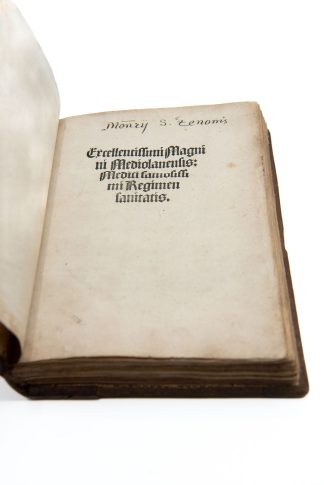MAINERI, MAINO de.
WITH MS VERSE ON PHLEBOTOMY
Regimen sanitatis.
[Strasbourg, Johann Pruss, 1503.]£7,850.00
4to. ff. [4], 105, lacking final blank. Roman letter, title in Gothic. Slight browning, 3 small worm holes to lower blank margin of F8. An excellent copy in contemporary northern French or Flemish quarter calf over bevelled wooden boards, rebacked, original spine onlaid, lacking clasp, triple blind ruled, blind roll of interlacing fleurons and birds, raised bands, leaf from c1500 printed ed. of a manual for confessors used as rear pastedown. Contemporary and slightly later ms annotations to front pastedown, C17 ms ‘Mon[aste]rij S. Zenonis’ to title, illegible early ink stamp to verso, ms note ‘Anno 1505 apo(?) dies S mathei ap[osto]li + Evangelisti Ego Johannes Palmacher p[res]b[ite]r bambergen[sis] dioce[sis] Ingr(?)sis su[per] religione[m] ordinis fratrum heremitarum siti Augustiniani + investitus p[er] venerandum patrem ac doctorem Johannem Staupiz Vicarium Eremitarum Ordinis Sanctitate Apostolica’ and ‘ihs xps’ to rear pastedown, and early C16 ms Latin verse on phlebotomy to Q7-8.
An attractive copy of this most important, popular work on health and nutrition. Maino de Maineri (or Magninus Mediolanensis, 1295-1368) was professor at Paris, physician to the Visconti in Milan as well as, for a short time, to Robert I, King of Scots. Written in Paris in 1331, the ‘Regimen’ was first printed in 1482, after a century of intense ms circulation; after 1504, it was regularly attributed to Arnaldus of Villanova. It is, like all of Maino’s works, devoted to the preservation of health, rather than pathology or diagnosis. Two sections were especially popular, and even circulated separately: on gynaecology and on culinary sauces. ‘For Maino, the process of writing was a combination of inherited learning and individual inspiration. […] one of the principal motivations for his composition […] was to make the wisdom of the authorities more accessible’, especially, as he stated in the preface, to the ‘poor unskilled, who have no access to even a fraction of the books, but who nonetheless would like to study this science’ (Proctor, p.40). His authorities included Galen, Rhazes, Avicenna, Isaac Israeli, Haly Abbas, Maimonides and Grosseteste. Part I introduces the nature of a ‘regimen’ and of health. Part II provides recommendations according to the patient’s complexion, sex, age (with a section on adolescents), habits and body, with specific advice for women. Part III discusses how exercise, baths, intercourse, sleep, and all kinds of food (and cooking methods) and drink, as well as clothes, can benefit one’s health. Part IV includes chapters on ways to remain healthy and avoid the plague and poisons (with a discussion of their flavours, and of poisonous mushrooms and truffles), while Part V is devoted to bloodletting methods, ‘pessaria’ and ‘cauteria’. This copy belonged to Johann Palmacher of Bamberg, who notes that, in 1505, he was consecrated a friar of the Augustinian Hermits by Johannes van Staupitz, Vicar of the Order, who would go on to meet and confess Martin Luther in 1506. Later, the copy was in the rich library of the Augustinian monastery of St Zeno, in Bad Reichenhall, Germany. Two early C16 annotators – probably the friars’ physicians – noted down recipes for improving digestion, as well as Latin rhyming verse beginning ‘Martini blasii philippi bartholomei / Hiis festis minuas & longo tempore vivas’ – a way to memorize the days and ways of bloodletting, examples of which are found in the margins of numerous C14 and C15 mss preserved in German libraries. A most interesting copy.
USTC 655177; VD16 M221; Durling 3042 (imperf.). Not in Wellcome (but now present), Heirs of Hippocrates or Osler. C. Proctor, ‘Perfecting prevention: the medical writings of Maino de Maineri (d.c. 1368)’, unpublished PhD thesis, Univ. of St Andrews, 2006.In stock







